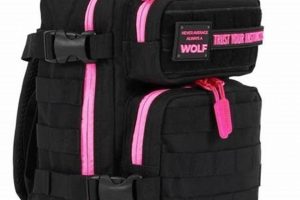A carrying solution designed specifically for the female anatomy by a reputable outdoor gear manufacturer. These products are engineered to provide a comfortable and efficient way to transport belongings, particularly during activities such as hiking, commuting, or traveling. Features often include contoured shoulder straps, a shorter torso length, and load-balancing systems tailored for a woman’s frame.
The significance of this specialized equipment lies in its improved fit and weight distribution compared to unisex or men’s designs. This leads to reduced strain on the back, shoulders, and neck, enhancing user comfort and preventing potential injuries. The North Face, a company with a long history of producing durable and reliable outdoor equipment, applies its expertise to create backpacks that withstand the rigors of daily use and outdoor adventures. Their commitment to quality materials and innovative designs ensures longevity and performance.
The following sections will delve into the specific features, types, and considerations when selecting a model that aligns with individual needs and intended use cases, addressing concerns related to capacity, durability, and intended activities.
Selection and Maintenance Guidelines
Careful consideration of several factors will ensure the optimal choice and prolonged lifespan of load-bearing equipment.
Tip 1: Prioritize Fit. Torso length is critical. Measure the distance from the C7 vertebra (the prominent bone at the base of the neck) to the iliac crest (the top of the hip bone) to determine the appropriate size. Consult the manufacturer’s sizing chart.
Tip 2: Assess Capacity Requirements. Evaluate the typical load volume. Day hikes generally require 20-30 liters; overnight trips necessitate 40-60 liters; extended expeditions may demand 65 liters or more. Overpacking compromises comfort and stability.
Tip 3: Examine Material Durability. High-denier fabrics, such as ripstop nylon, provide superior resistance to abrasion and tears. Reinforced stitching at stress points enhances structural integrity. Verify the denier rating and material composition prior to purchase.
Tip 4: Evaluate Suspension System. Contoured shoulder straps, a padded hip belt, and a sternum strap are essential for effective weight distribution. Ensure adequate padding to prevent pressure points and chafing, particularly during prolonged use.
Tip 5: Inspect Organizational Features. Multiple compartments, pockets, and attachment points facilitate efficient packing and accessibility. Consider features such as hydration reservoir compatibility, trekking pole attachments, and external gear loops based on specific activity needs.
Tip 6: Implement Regular Cleaning. Remove dirt and debris regularly using a soft brush and mild soap. Avoid harsh detergents or bleach, which can damage fabric and coatings. Allow the item to air dry thoroughly before storage.
Tip 7: Proper Storage Techniques. Store the pack in a cool, dry place away from direct sunlight to prevent degradation of materials. Avoid compressing the structure excessively, as this can damage the frame and padding.
Adherence to these guidelines promotes informed decision-making and ensures that the selected product aligns with intended usage and environmental conditions. This, in turn, maximizes comfort, efficiency, and longevity.
The following section will address common misconceptions and offer expert insights regarding performance characteristics and suitable applications.
1. Anatomical Fit
Anatomical fit is a critical design consideration in the context of carrying solutions, specifically influencing the comfort, stability, and overall performance of equipment intended for female users.
- Torso Length Accommodation
Manufacturers recognize that female torso lengths are, on average, shorter than those of males. Therefore, models incorporate reduced back panel lengths to position the hip belt correctly. Proper hip belt placement ensures that a significant portion of the load is borne by the hips, minimizing strain on the shoulders and spine. An incorrectly sized backpack can lead to discomfort and potential musculoskeletal issues, particularly during prolonged use.
- Shoulder Strap Contouring
Shoulder straps are typically narrower and more curved in these designs to accommodate the contours of the female chest and shoulders. This prevents chafing and binding, which can occur with unisex or male-specific designs. The S-shape design of the shoulder straps ensures a comfortable and secure fit, preventing slippage and optimizing weight distribution across the shoulders.
- Hip Belt Angle and Padding
The angle and padding of the hip belt are adjusted to conform to the female pelvic structure. The hip belt is designed to sit comfortably on the iliac crest, effectively transferring the weight of the pack to the hips. Additional padding is often incorporated to provide cushioning and prevent pressure points, enhancing comfort during extended periods of wear.
- Load Lifter Adjustments
Load lifter straps, which connect the shoulder straps to the top of the pack frame, are essential for maintaining proper posture and stability. These straps are positioned to pull the load closer to the wearer’s center of gravity, preventing the pack from sagging or swaying. Proper adjustment of the load lifter straps ensures that the weight is evenly distributed, minimizing strain on the back and shoulders.
These anatomical design considerations underscore the importance of selecting a product that aligns with individual body dimensions and intended use. Failure to prioritize anatomical fit can compromise comfort, stability, and overall performance, ultimately detracting from the user’s experience. Proper fit is fundamental for optimizing the benefits of carrying equipment during diverse activities, from hiking and backpacking to commuting and traveling.
2. Load Distribution
Effective load distribution is paramount in backpack design, especially in equipment engineered for the female anatomy. The design philosophy behind The North Face’s women’s line directly addresses the need to transfer weight efficiently from the shoulders and back to the hips, thereby minimizing strain and fatigue. Poor load distribution can lead to discomfort, muscle imbalances, and potential injury, particularly during prolonged activity. The integration of adjustable torso lengths, contoured shoulder straps, and strategically padded hip belts directly influences how weight is distributed across the body. These features work in concert to maintain a stable center of gravity and promote ergonomic carrying.
Consider a hiker traversing mountainous terrain. A poorly designed backpack would concentrate weight on the shoulders, causing them to hunch forward and resulting in lower back pain. However, a backpack with proper load distribution, featuring a supportive hip belt, would shift the majority of the weight to the hips and legs, allowing for a more upright posture and efficient movement. This translates to increased endurance and reduced risk of injury. Another example is a student commuting to campus. A backpack not designed for optimal load distribution could cause strain on the upper back and neck due to improper weight balance, contributing to discomfort and fatigue throughout the day. The North Face’s consideration of anatomical fit and integrated suspension systems mitigates these issues by ensuring a more balanced and comfortable carry.
In summary, load distribution is not merely a feature but a fundamental design principle that dictates the usability and comfort of backpacks intended for women. The careful consideration of torso length, shoulder strap contouring, and hip belt construction ensures that weight is distributed efficiently, mitigating strain and promoting ergonomic carrying. While advancements in materials and design continue, the principles of effective load distribution remain central to The North Face’s commitment to providing performance-driven equipment.
3. Capacity Options
Capacity options are a critical consideration when selecting load-bearing equipment, directly influencing its utility and suitability for various activities. The North Faces offerings for women encompass a range of capacities tailored to accommodate diverse needs, from day hikes to multi-day expeditions.
- Daypacks (15-30 Liters)
These smaller models are designed for shorter excursions or everyday use. They typically accommodate essentials such as water bottles, snacks, extra layers, and small personal items. For instance, a student might use a 25-liter pack to carry books, a laptop, and lunch to campus. The compact size maintains maneuverability and reduces unnecessary bulk.
- Overnight Packs (30-50 Liters)
Packs within this range are suitable for overnight camping trips or extended day hikes where additional gear is required. They can accommodate a lightweight sleeping bag, a small tent, cooking supplies, and extra clothing. A weekend backpacking trip necessitating a tent, sleeping bag, and food supplies would fall under this category. The increased capacity demands a more robust suspension system for comfortable weight distribution.
- Multi-Day Packs (50-75+ Liters)
Larger-capacity packs are designed for extended backpacking trips lasting several days or weeks. These models can accommodate larger tents, sleeping bags, cooking equipment, and ample clothing. A mountaineering expedition requiring specialized gear and provisions necessitates a pack of this size. Durability and a highly supportive suspension system are paramount to managing heavier loads effectively.
- Specialized Packs
Beyond the general ranges, specialized models exist with unique capacity considerations. For example, a hydration pack designed for running or cycling may have a smaller overall capacity (under 15 liters) but prioritize water storage and accessibility. Similarly, a travel pack designed for air travel may prioritize dimensions that meet carry-on restrictions, regardless of total volume. Understanding the specific purpose and intended use case is crucial in selecting the appropriate capacity.
The selection of an appropriate capacity significantly impacts user comfort and performance. Choosing a pack that is too small restricts the ability to carry essential gear, while selecting a pack that is excessively large can lead to unnecessary weight and discomfort. The North Face’s diverse capacity options, coupled with their focus on anatomical fit and load distribution, aim to provide women with a solution optimized for their specific needs and activities. Careful consideration of intended use, trip duration, and gear requirements is essential in making an informed decision.
4. Material Durability
Material durability forms a cornerstone in the performance and longevity of a carrying solution, directly impacting the value proposition of equipment produced by The North Face. A higher degree of material durability translates into a longer lifespan for the product, reducing the frequency of replacement and mitigating the environmental impact associated with manufacturing new goods. The company’s choice of materials and construction techniques is inextricably linked to its reputation for producing reliable outdoor gear, especially within its women’s line. Consider a scenario involving a multi-day backpacking trip through rugged terrain. A backpack constructed from inferior materials would be susceptible to tears, abrasions, and seam failures, potentially compromising the user’s ability to carry essential supplies. Conversely, a backpack constructed from high-denier nylon or polyester, with reinforced stitching and strategically placed abrasion-resistant panels, would withstand these challenges, ensuring the safe and secure transport of equipment.
The implementation of durable materials extends beyond the primary fabric of the backpack. Components such as zippers, buckles, and webbing also contribute significantly to overall product resilience. A failure in any of these elements can render the entire pack unusable. The North Face typically employs robust zippers from reputable manufacturers, known for their resistance to breakage and smooth operation, even under stress. Buckles are selected for their impact resistance and ability to withstand repeated use in demanding conditions. Seam construction further contributes to material integrity. Reinforced stitching, bar tacking at stress points, and the use of durable thread enhance the resistance of seams to tearing and separation. This meticulous attention to detail in material selection and construction methods is indicative of a commitment to providing consumers with products that withstand the rigors of both daily use and more demanding outdoor pursuits.
In summary, material durability is not merely a superficial attribute but a critical determinant of the performance, reliability, and lifespan of carrying equipment, especially within the North Face backpack women’s line. The company’s strategic selection of high-quality materials, coupled with meticulous construction techniques, directly translates into a product that withstands environmental stressors, minimizes the risk of failure, and provides lasting value to the end-user. Understanding the interplay between material properties and product design is essential for making informed purchasing decisions and ensuring that the chosen equipment aligns with anticipated usage scenarios.
5. Weather Resistance
Weather resistance is a fundamental attribute, and therefore an essential design consideration, for any carrying solution intended for outdoor use. The capacity of a “north face backpack women’s” to withstand adverse weather conditions directly affects the protection of its contents, the comfort of the user, and the overall longevity of the product. The relationship between environmental exposure and equipment performance is causal: precipitation, humidity, and ultraviolet radiation can degrade materials, compromise functionality, and lead to equipment failure. Consequently, weather resistance is not merely an added feature but an integral component of the products performance.
The materials used in these products, such as coated nylon or polyester, are selected for their inherent water-repellent properties. However, the construction methods employed are equally important. Seams are often sealed or taped to prevent water ingress, and zippers may be water-resistant or feature storm flaps. For instance, a hiker caught in a sudden downpour relies on the weather resistance of their backpack to keep critical gear, such as a sleeping bag, dry and functional. Failure to do so could lead to hypothermia and compromise the entire expedition. Similarly, a commuter navigating a rain-soaked city needs assurance that their electronic devices and important documents are shielded from moisture damage.
In conclusion, weather resistance is a core attribute intrinsically linked to the usability and reliability of a “north face backpack women’s”. The selection of water-repellent materials, combined with meticulous construction techniques, ensures that the contents of the pack remain protected from the elements. Recognizing the practical significance of weather resistance allows consumers to make informed decisions, aligning their equipment choices with the demands of their intended activities and environments. The ability of a product to withstand exposure to environmental factors directly affects user comfort, safety, and the overall value derived from the investment.
6. Organizational Features
Organizational features are integral to the utility and efficiency of load-bearing equipment. The presence and design of compartments, pockets, and attachment points directly influence the ease with which items can be packed, accessed, and secured. For a product like a “north face backpack women’s”, these features contribute significantly to its functionality, catering to the diverse needs of the intended user base. The impact of well-designed organizational elements is multifaceted. Effective compartmentalization prevents items from shifting during movement, reducing the risk of damage and maintaining a more stable center of gravity. Strategically placed pockets provide quick access to frequently used items, such as water bottles, phones, or maps, without requiring the wearer to remove the pack. Attachment points allow for the secure transport of external gear, such as trekking poles or ice axes, freeing up internal space and preventing these items from becoming a safety hazard.
The practical implications of organizational features can be illustrated through several examples. Consider a commuter using their backpack to transport work-related materials. A dedicated laptop sleeve, padded and securely positioned, protects the device from damage during transit. Multiple smaller pockets allow for the segregation of pens, chargers, and other accessories, preventing them from becoming tangled or lost. A student utilizing the backpack for academic purposes benefits from similar organizational solutions. Designated compartments for textbooks, notebooks, and writing implements streamline the packing process and facilitate quick retrieval of specific items. A hiker embarking on a day trip requires a different set of organizational features. External water bottle pockets ensure easy hydration, while a separate compartment for a first-aid kit provides quick access in case of emergencies. Attachment points for trekking poles enable hands-free movement on uneven terrain. The specific organizational elements incorporated into a “north face backpack women’s” are directly related to its intended use case. Models designed for hiking prioritize external attachment points and hydration compatibility, while those designed for commuting emphasize laptop protection and internal organization.
In summary, organizational features are not merely cosmetic additions but rather essential design components that directly impact the usability and efficiency of a “north face backpack women’s”. The strategic placement of compartments, pockets, and attachment points facilitates efficient packing, quick access to essential items, and secure transport of gear. The effectiveness of these features is contingent upon their alignment with the intended use case, whether it be commuting, hiking, or traveling. By prioritizing well-designed organizational elements, manufacturers can enhance the overall user experience and increase the value proposition of their products.
7. Activity Specificity
Activity specificity is a core design principle influencing the functionality and effectiveness of carrying solutions. The design parameters of a “north face backpack women’s” are intrinsically linked to the intended activity, with variations in capacity, features, and construction tailored to specific use cases. The cause-and-effect relationship is evident: the selection of a backpack ill-suited for the intended activity can result in discomfort, inefficiency, and, in extreme cases, safety risks. The importance of activity specificity as a component of a “north face backpack women’s” stems from the necessity to optimize performance and user experience. For example, a hiking backpack requires features such as hydration compatibility, trekking pole attachments, and a robust suspension system to distribute weight effectively over uneven terrain. In contrast, a commuting backpack may prioritize a padded laptop sleeve, organizational pockets, and a streamlined profile for navigating crowded urban environments. These divergent requirements underscore the critical need for activity-specific designs.
The practical significance of understanding activity specificity extends to informed purchasing decisions. Consumers who recognize the link between activity and backpack design are better equipped to select a product that meets their individual needs. For instance, a trail runner would benefit from a lightweight hydration pack with a minimalist design, while a multi-day backpacker would require a larger capacity pack with a more complex suspension system. Real-world examples highlight the benefits of this understanding. A hiker using a poorly fitted, general-purpose backpack on a strenuous trek may experience discomfort and fatigue, while a hiker using a properly fitted, activity-specific backpack would enjoy a more comfortable and efficient experience. The North Face’s product line caters to this diversity, offering a range of backpacks designed for hiking, camping, commuting, travel, and other activities. This specialization ensures that users can find a product that aligns with their specific needs.
In summary, activity specificity is a fundamental design principle governing the creation and selection of a “north face backpack women’s”. The connection between intended use and backpack design is causal, directly affecting user comfort, efficiency, and safety. The challenges lie in accurately assessing individual needs and selecting a product that aligns with those needs. By understanding the importance of activity specificity, consumers can make informed decisions and select a backpack that enhances their overall experience, regardless of the chosen activity.
Frequently Asked Questions
This section addresses common inquiries regarding the selection, usage, and maintenance of load-bearing equipment designed specifically for the female anatomy. These questions aim to clarify key considerations and dispel misconceptions surrounding such products.
Question 1: What distinguishes a “north face backpack women’s” from a unisex model?
The primary distinctions lie in the anatomical fit. Specifically, designs incorporate shorter torso lengths, contoured shoulder straps, and hip belts tailored to the female form. These adjustments aim to optimize weight distribution and minimize strain on the shoulders and back.
Question 2: How is the appropriate torso length determined for optimal fit?
Torso length is measured from the C7 vertebra (the prominent bone at the base of the neck) to the iliac crest (the top of the hip bone). Consult the manufacturer’s sizing chart to correlate torso length with recommended backpack size. Proper fit ensures effective weight transfer to the hips.
Question 3: What capacity is suitable for day hiking versus multi-day backpacking?
Day hikes typically necessitate a capacity of 20-30 liters, accommodating essentials such as water, snacks, and extra layers. Multi-day backpacking trips generally require 50-75+ liters to accommodate camping equipment, cooking supplies, and additional provisions.
Question 4: How should a “north face backpack women’s” be properly cleaned and stored?
Clean the pack using a soft brush and mild soap. Avoid harsh detergents or bleach. Allow the pack to air dry thoroughly before storing it in a cool, dry place away from direct sunlight. Avoid excessive compression during storage to prevent damage to the frame and padding.
Question 5: What materials offer the best durability for withstanding abrasive environments?
High-denier fabrics, such as ripstop nylon or polyester, provide superior abrasion resistance. Reinforced stitching at stress points and durable zippers are also crucial for enhancing overall durability.
Question 6: How can weather resistance be enhanced for prolonged exposure to inclement conditions?
Consider models featuring water-resistant fabrics, taped seams, and storm flaps over zippers. Additionally, a rain cover can provide an extra layer of protection during heavy precipitation. Regular application of a durable water repellent (DWR) treatment can also improve water resistance.
In summary, proper selection, usage, and maintenance are essential for maximizing the performance and longevity of carrying equipment designed for women. Understanding anatomical fit, capacity requirements, material durability, and weather resistance are crucial for making informed decisions.
The following section will explore alternative brands and comparative analyses.
North Face Backpack Women’s
The preceding exploration has underscored the significance of anatomically-sound design, material durability, and activity-specific features in load-bearing equipment. Selection necessitates a careful evaluation of individual needs, intended use cases, and environmental conditions. The convergence of fit, function, and resilience determines the ultimate performance and longevity of a carrying solution.
Understanding these factors empowers informed decision-making, ensuring that selected equipment aligns with specific demands. The pursuit of optimal performance requires a commitment to quality and an appreciation for the technical nuances of design. This approach facilitates responsible consumption and promotes the enduring value of well-engineered products.



![Best Adidas Women Backpack [Deals!] Your Style Ultimate Backpack Traveler Guide: Tips, Destinations & Budget Hacks Best Adidas Women Backpack [Deals!] Your Style | Ultimate Backpack Traveler Guide: Tips, Destinations & Budget Hacks](https://backpack-traveler.com/wp-content/uploads/2025/10/th-1060-300x200.jpg)



